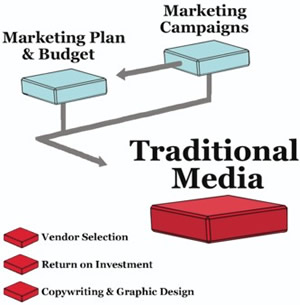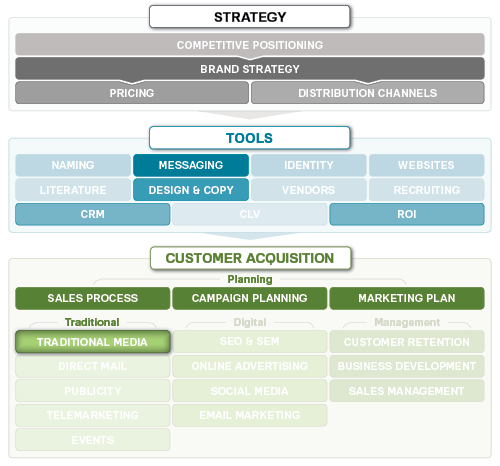Marketing Guides
Campaigns & Execution
Traditional Media Examples
Marketers have used traditional media such as print, radio, TV, yellow pages and even outdoor ads to reach consumer markets for the last 50 to 100 years.
Traditional media can also play a role in the marketing mix for many B2B companies. These media often reach a broad audience and thus can be relatively expensive. Yet in your industry or region, they may be very effective in helping you reach your market.
Here are a some traditional media examples:
- In many industries, print ads in monthly trade journals are an important vehicle to reach decision makers.
- If your company sells to a certain geographic region, directory listings and ads may be crucial for reaching buyers when they’re searching for solutions.
- You may need to reach a wide variety of prospects in different industries, so you may advertise in a regional or national business publication, newspaper or radio program.
You can use these media to generate leads, build visibility, share your message and/or drive specific promotions. They’re especially helpful when you use them in conjunction with other media in a larger campaign.
Here are two sample traditional media examples:
| USE PRINT & ONLINE TO GENERATE LEADS | USE RADIO TO GENERATE LEADS & AWARENESS |
|---|---|
| To generate leads, you run a print ad in an industry journal and a banner on the publication’s website and monthly subscriber email.
The prospect calls to take advantage of your offer or visits a unique landing page on your website, then fills out a form. A sales rep calls and sets up an in-person presentation. |
You run a schedule of :30 ads on a talk radio show that reaches a broad base of business people in your industry or region.
As part of your package, you buy exclusive sponsorship of the show. You receive special mentions throughout the show, and you use the entire campaign to drive traffic to a specific landing page on your website. The page continues your message, captures the prospect’s information or encourages a phone call. Your telemarketing team qualifies leads and transfers hot prospects to your sales team. |
It’s important to treat these programs as longer-term investments because responses tend to come in gradually — they aren’t as immediate or measurable as internet marketing, telemarketing or direct mail.
Targeting may be an issue and you may not be able to measure the branding impact of your campaign, but they’re solid vehicles when they’re in line with your goals or used in a larger campaign.
| Best Case | Neutral Case | Worst Case |
|---|---|---|
| You understand the strengths and limitations of traditional media, and you use them effectively in campaigns to drive awareness and response.
You test your campaigns to improve over time and you measure the campaigns to the best of your ability. While you don’t measure the value of your brand-building, you do adjust your ROI calculations to incorporate an allowance for that value. |
You run a sprinkling of traditional media campaigns and track the number of calls they generate. You know they work to some degree, but you can’t quantify the results that well.
The ads themselves are about average but you rarely test them to improve. You know it’s important to be in the vehicles you choose, and you stick with the same tactics because your competitors are doing the same thing. |
You don’t evaluate your buys very carefully; you don’t have specific goals and thus can’t measure whether you’re successful or not.
You don’t really test your ads either – they offer a lot of information and you can’t really say whether they work either for branding or direct response. You’re wasting your budget and time on programs that could be vastly improved. |
Not Sure Where to Start with Traditional Media?
Access detailed step-by-step plans in our new marketing website.
It’s free to use

Traditional Media Examples Concepts & Steps
Before you begin
Make sure your campaigns are tied to the goals in your marketing plan.
Develop a strong strategy
First, determine what you need to accomplish. For example, you may need to generate a specific number of leads, raise your visibility in a certain industry or geography, or communicate a key message across different media. Set tangible goals for your media plan.
Each media has benefits and drawbacks. When you’ve defined your goals, you can decide which vehicle will work best. Make sure you know how to measure your campaign as well.
Decide whether to buy traditional media in-house or through an agency
Media buying can be a tricky and time-consuming process. If you have a lot of media to buy, you may want to hire an agency. You’ll pay for their services, but they may also have more buying power to negotiate better deals and find ways to reach your target market more cost-effectively.
Consider targeting when comparing costs
Media sales reps may quote you a flat rate for a particular ad or they may quote a cost per thousand (CPM) impressions. You may pay a higher CPM for a more targeted media than a general one, but if you calculate your cost per targeted impression instead, you can truly compare apples to apples.
Create a compelling ad and call-to-action
Your ad needs to grab the attention of your market – be creative, but keep your message simple and clear. Include a call-to-action: Encourage prospects to call or visit a special landing page to learn more about a particular offer or program.
Continually test, refine and improve
It’s wise to test any campaign before spending your entire budget. If you’re considering multiple publications, run the same ad in two different ones to see which generates the best response. Or test different headlines and offers. Your goal is to find the ads and publications that generate the best response, then run them for the remainder of your campaign.
After Traditional Media
Keep testing and refining your campaigns so they deliver on your goals.
TRADITIONAL MEDIA PLANNING TEMPLATES / MARKETING PLANS / PROJECT MANAGEMENT
EVERYTHING YOU NEED FOR YOUR TRADITIONAL MEDIA PROJECT
